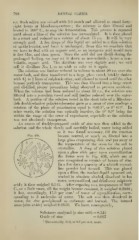Page 788 - My FlipBook
P. 788
798 DENTAL CARIES.
c.c. fresh saliva are mixed M'itli 2.0 starch and allowed to stand forty-
eight hours at blood-temj)erature ; the mixture is then filtered and
heated to 100° C, to stop the fermentation. This process is repeated
until about a litre of the solution has accumulated. It is then placed
in a retort and reduced to a volume of about 75 c.c. It will be very
strongly acid. A few drops of this liquid are added to a thin solution
of methyl-violet, and leave it unchanged ; from this we conclude that
we have to deal with an organic acid, as an inorganic acid ^vould turn
it first blue, and then green. Since the acid did not distill during the
prolonged boiling, we may set it down as non-volatile ; hence a non-
volatile, organic acid. The distillate was ver}' slightly acid ; we will
call it distillate No. 1, as we wish to refer to it again.
The solution was further reduced in volume to about 40 c.c. over the
water-bath, and then transferred to a large glass vessel, briskly shaken
with 1^ to 2 litres of sulphuric ether, and allowed to stand until the ether
became perfectly transparent. This was then filtered into a large retort
and distilled, proper precautions being observed to prevent accidents.
AMien the volume had been reduced to about 50 c.c, the solution was
filtered into a porcelain vessel and still further reduced over the water-
bath. A portion of the solution tested in the short tube of a Mitscher-
lich double-shadoM' polaristrobometer gave as a mean of nine readings a
rotation of the plane of polarization equal to 0.015°, or 0° 0.9'. In
other words, the solution w^as optically inactive, the 0° 0.9' being fiir
within the range of the error of experiment, especially as the solution
was not absolutely transparent.
An excess of freshly-prepared oxide of zinc was then added to the
solution and the whole slowly and carefully boiled, Avater being added
as it was found necessary, till the reaction
Fk;. 409. became neutral, or nearly so, filtered into a
large glass evaporating dish, and put away at
the temperature of the room for the salt to
crystallize. A drop of this solution placed
uj)on a glass slide gave upon crystallization
the forms seen in Fig. 409, which are at
once recognized as crystals of lactate of zinc.
In a few days a quantity of a whitish crystal-
line powder had formed. This was placed
upon a filter, the mother-liquid squeezed out,
washed in absolute alcohol, dissolved in hot
water, recrystallized, and dried over sulphuric
acid ; it then weighed 0.343. After exposing to a temperature of 100°
C, or a little more, till the weight became constant, it weighed 0.2816
;
it lost, accordingly, 17.9 per cent.^ of water of crystallization, corre-
sponding to 3 molecules of water. The salt was then dissolved in
Mater, the zinc precij^itated as carbonate and burned. The burned
mass (zinc oxide) weighed 0.0970. AVe have, consequently,
Substance analyzed (a zinc salt) = 0.343
*
Oxide of zinc = 0.097
^ Theoretically, 18.2, or 0.3 per cent. more.


